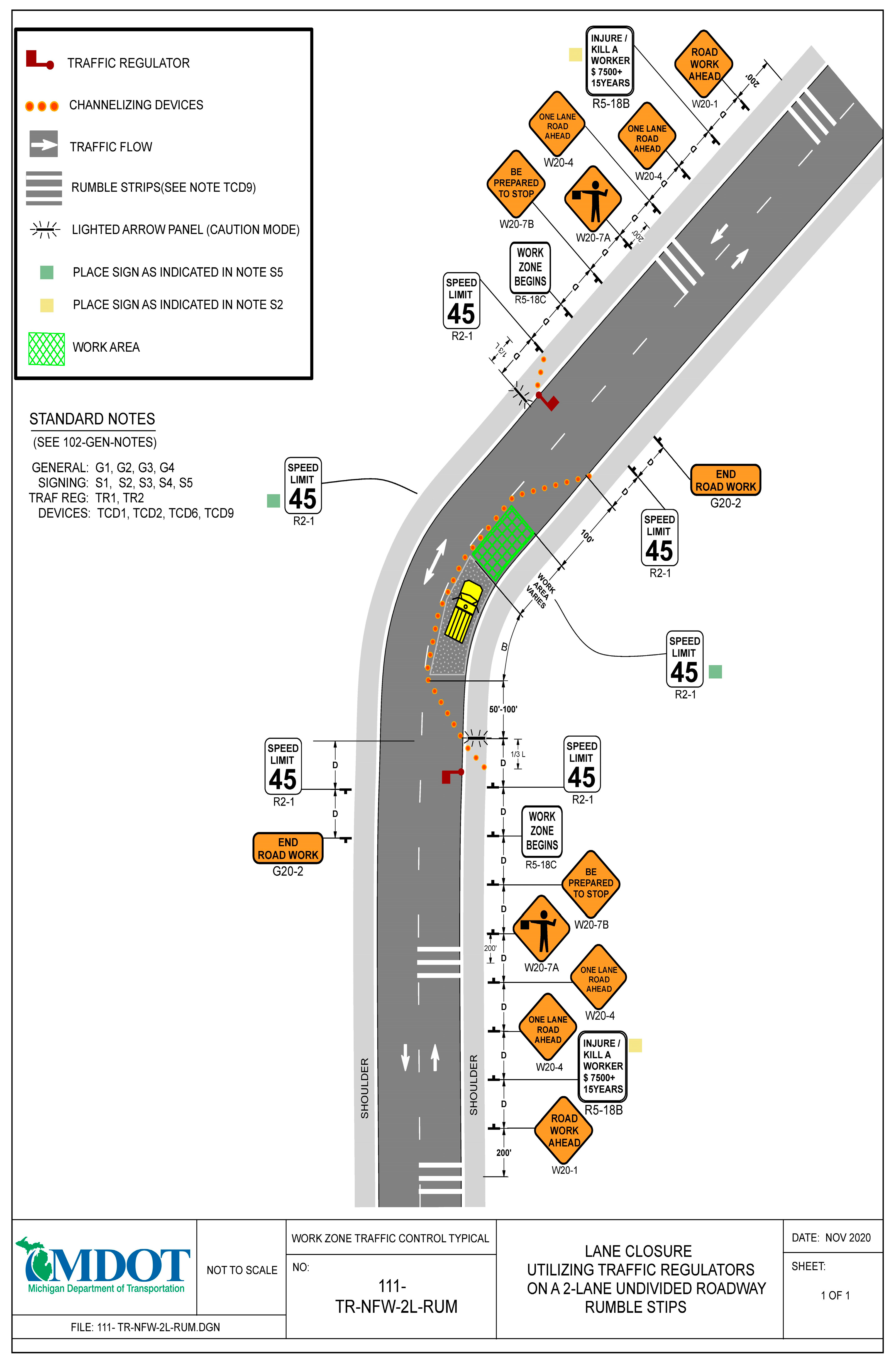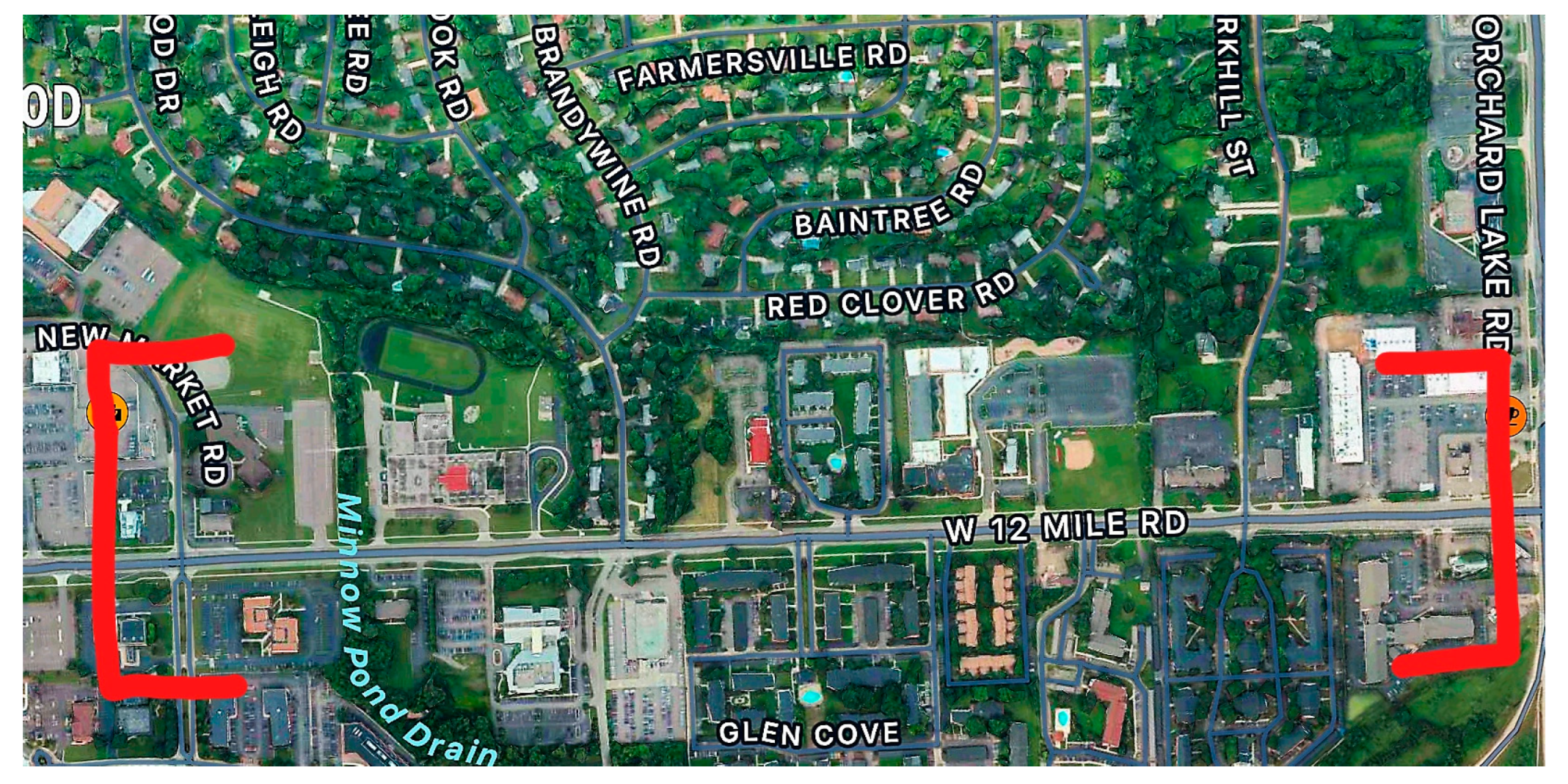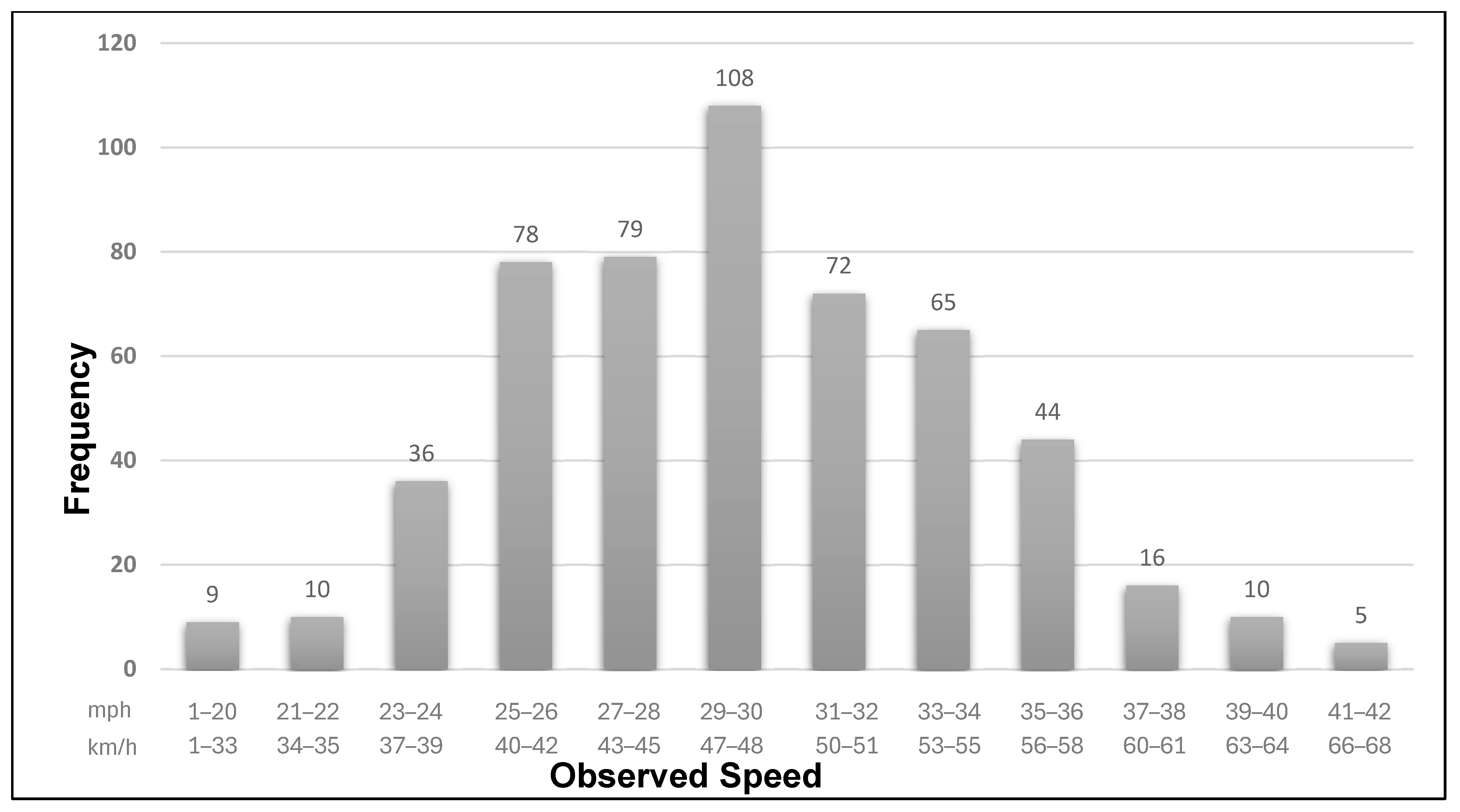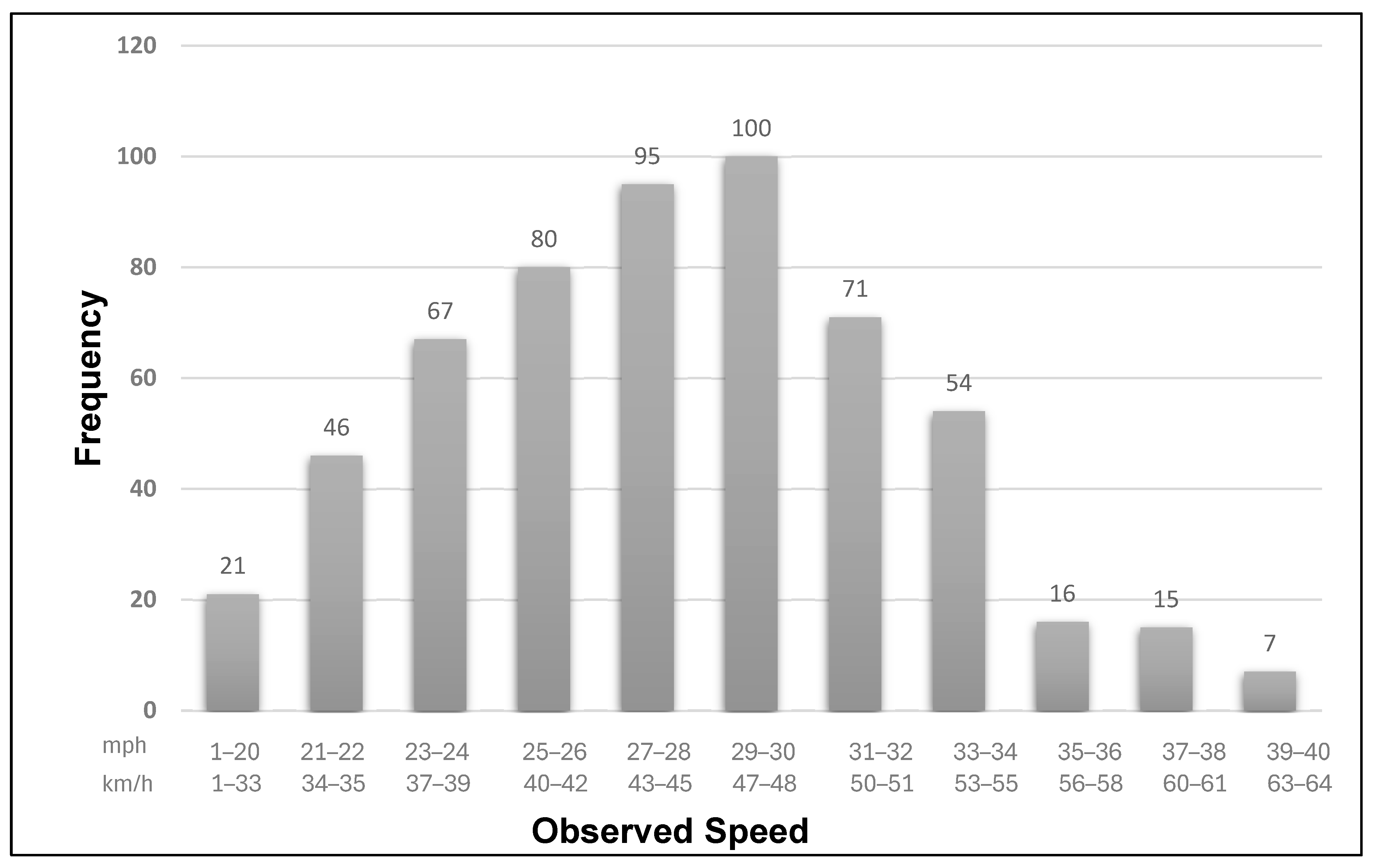The Effects of Temporary Portable Rumble Strips on Vehicle Speeds in Road Work Zones
Abstract
:1. Introduction
2. Research Objectives and Methodology
- The field test started on W 12 Mile Road was started at 10:00 a.m. without TPRSs. In the beginning, two speed counters were installed at 1080 feet from the Orchard Lake Road intersection on both traveling lanes. The speeds of moving cars were collected for an hour, until 11:00 a.m. Figure 3 shows the test configuration.
- TPRSs were installed on W 12 Mile Road, west bound (WB), 360 feet from the speed counters and 720 feet from the Orchard Lake Road intersection at 11:00 a.m. for one hour. The TPRS configuration consisted of one array containing three TPRSs with a layout of 15 feet, center to center, between every TPRS. Figure 4 shows the test configuration.
3. Study Findings
4. Concluding Remarks
Author Contributions
Funding
Institutional Review Board Statement
Informed Consent Statement
Data Availability Statement
Conflicts of Interest
References
- Al-Bayati, A.J.; Bilal, G.A.; Esmaeili, B.; Karakhan, A.; York, D. Evaluating OSHA’s fatality and catastrophe investigation summaries: Arc flash focus. Saf. Sci. 2021, 140, 105287. [Google Scholar] [CrossRef]
- The National Institute for Occupational Safety and Health (NIOSH). Highway Work Zone Safety. The National Institute for Occupational Safety and Health. 2019. Available online: https://www.cdc.gov/niosh/topics/highwayworkzones/ (accessed on 1 January 2020).
- Sakhakarmi, S.; Park, J. Improved intrusion accident management using haptic signals in roadway work zone. J. Saf. Res. 2022, 80, 320–329. [Google Scholar] [CrossRef]
- Federal Highway Administration, (FHWA). FHWA Work Zone Facts and Statistics. 2018. Available online: https://ops.fhwa.dot.gov/wz/resources/facts_stats.htm (accessed on 1 January 2020).
- Mishra, S.; Golias, M.M.; Thapa, D. Work Zone Alert Systems; Department of Transportation: Nashville, TN, USA, 2021. [Google Scholar]
- Thapa, D.; Mishra, S. Using worker’s naturalistic response to determine and analyze work zone crashes in the presence of work zone intrusion alert systems. Accid. Anal. Prev. 2021, 156, 106125. [Google Scholar] [CrossRef]
- Yang, H.; Ozbay, K.; Ozturk, O.; Xie, K. Work zone safety analysis and modeling: A state-of-the-art review. Traffic Inj. Prev. 2015, 16, 387–396. [Google Scholar] [CrossRef] [PubMed]
- Ullman, G.L.; Lomax, T.J.; Scriba, T. A Primer on Work Zone Safety and Mobility Performance Measurement; Federal Highway Administration, Office of Operations: Washington, DC, USA, 2011. [Google Scholar]
- Li, Y.; Hu, Y.; Xia, B.; Skitmore, M.; Li, H. Proactive behavior-based system for controlling safety risks in urban highway construction megaprojects. Autom. Constr. 2018, 95, 118–128. [Google Scholar] [CrossRef]
- BLS, B.o.L.S (Bureau of Labor Statistics). (Injuries, Illnesses, and Fatalities). 2019. Available online: https://www.bls.gov/iif/oshwc/cfoi/cftb0331.htm (accessed on 1 January 2020).
- Nnaji, C.; Gambatese, J.; Lee, H.W.; Zhang, F. Improving construction work zone safety using technology: A systematic review of applicable technologies. J. Traffic Transp. Eng. 2020, 7, 61–75. [Google Scholar] [CrossRef]
- McNally, A.; Kosnett, A.; Crachiola, C.; Rasmussen, B.; Frankil, M. US Fish and Wildlife Service Manual on Uniform Traffic Control Devices Digest; John A. Volpe National Transportation Systems Center: Cambridge, MA, USA, 2021. [Google Scholar]
- Al-Bayati, A.J.; Ali, M.; Nnaji, C. Managing Work Zone Safety during Road Maintenance and Construction Activities: Challenges and Opportunities. Pract. Period. Struct. Des. Constr. 2023, 28, 04022068. [Google Scholar] [CrossRef]
- Agencies, L. Temporary Traffic Control Handbook for Local Agencies. 2016. Available online: https://publications.iowa.gov/21890/ (accessed on 1 January 2020).
- Fan, W.; Choe, S.; Leite, F. Prevention of backover fatalities in highway work zones: A synthesis of current practices and recommendations. Int. J. Transp. Sci. Technol. 2014, 3, 311–337. [Google Scholar] [CrossRef]
- Zhu, Z.; Edara, P.; Sun, C. Case study of an alternative merging sign design for temporary traffic control in work zones. J. Transp. Eng. 2016, 142, 05015005. [Google Scholar] [CrossRef]
- Brewer, M.A.; Pesti, G.; Schneider IV, W. Improving compliance with work zone speed limits: Effectiveness of selected devices. Transp. Res. Rec. 2006, 1948, 67–76. [Google Scholar] [CrossRef]
- Zhang, F.; Gambatese, J.A. Highway construction work-zone safety: Effectiveness of traffic-control devices. Pract. Period. Struct. Des. Constr. 2017, 22, 04017010. [Google Scholar] [CrossRef]
- Edara, P.; Sun, C.; Keller, C.; Hou, Y. Evaluation of dynamic message signs on rural freeways: Case study of a full freeway closure. J. Transp. Eng. 2014, 140, 89–98. [Google Scholar] [CrossRef]
- Nnaji, C.; Gambatese, J.; Lee, H.W. Work zone intrusion: Technology to reduce injuries and fatalities. Prof. Saf. 2018, 63, 36–41. [Google Scholar]
- Rathnasiri, N.; De Silva, N.; Wijesundara, J. State of the art in work zone safety: A systematic review. Int. J. Transp. Sci. Technol. 2024, 13, 14–28. [Google Scholar] [CrossRef]
- Ghasemzadeh, A.; Ahmed, M.M. Exploring factors contributing to injury severity at work zones considering adverse weather conditions. IATSS Res. 2019, 43, 131–138. [Google Scholar] [CrossRef]
- Alhomaidat, F.; Kwigizile, V.; Oh, J.S.; Van Houten, R. How does an increased freeway speed limit influence the frequency of crashes on adjacent roads? Accid. Anal. Prev. 2020, 136, 105433. [Google Scholar] [CrossRef]
- Hanandeh, S.; Khliefat, I.; Hanandeh, R.; Alhomaidat, F. Modelling the free flow speed and 85th percentile speed using artificial neural network (ANN) and genetic algorithm. Int. Rev. Civ. Eng. 2022, 13, 296–308. [Google Scholar] [CrossRef]
- Alhomaidat, F.; Hasan, R.A.; Hanandeh, S.; Alhajyaseen, W. Using driving simulator to study the effect of crash fact signs on speeding behaviour along freeways. Int. J. Inj. Control Saf. Promot. 2023, 30, 15–25. [Google Scholar] [CrossRef] [PubMed]
- National Highway Traffic Safety Administration. Traffic Safety Facts 2015: Speeding; No. DOT HS 812 409; U.S. Department of Transportation, National Highway Traffic Safety Administration: Washington, DC, USA, 2017; pp. 2006–2014. [Google Scholar]
- Taylor, W. The Impact of Raising the Speed Limit on Freeways in Michigan; Michigan Department of Transportation: East Lansing, MI, USA, 2000. [Google Scholar]
- Gates, T.; Savolainen, P.; Kay, J.; Finkelman, J.; Davis, A. Evaluating Outcomes of Raising Speed Limits on High Speed Non-Freeways; Department of Transportation, Office of Research Administration: East Lansing, MI, USA, 2015. [Google Scholar]
- Kwigizile, V.; Oh, J.; Cho, R.H.; Kwayu, K.; Villalobos, G. Evaluating the Impacts of Speed Limit Changes on Identified Case Studies. 2017. Available online: https://mdotjboss.state.mi.us/TSSD/getTSDocument.htm?docGuid=cecc19d9-ea5e-4411-b65c-d2a9a1ad38a4&fileName=SPR-1648-Report.pdf (accessed on 1 January 2020).
- Genders, W.; Razavi, S.N. Impact of Connected Vehicle on Work Zone Network Safety through Dynamic Route Guidance. J. Comput. Civ. Eng. 2016, 30, 04015020–04015021. [Google Scholar] [CrossRef]
- Debnath, A.K.; Blackman, R.; Haworth, N. Common hazards and their mitigating measures in work zones: A qualitative study of worker perceptions. Saf. Sci. 2015, 75, 293–301. [Google Scholar] [CrossRef]
- Michigan Department of Transportation, MDOT. Work Zone Safety and Mobility Manual, WZSM, “Portable Temporary Transverse Rumble Strips—Non-Freeway” 6.01.18.C. 2021. Available online: https://www.michigan.gov/mdot/-/media/Project/Websites/MDOT/Business/Work-Zone-Mobility/Work-Zone-Safety-Mobility-Manual.pdf (accessed on 1 January 2020).
- Federal Highway Administration. Traffic Monitoring Guide. Federal Highway Administration Traffic Monitoring Guide. 2022. Available online: https://www.fhwa.dot.gov/policyinformation/tmguide/2022_TMG_Final_Report.pdf (accessed on 1 January 2020).
- Roberts, C.A.; Smaglik, E.J. Driver feedback on monetary penalty and its impact on work zone speed. Transp. Res. Rec. 2012, 2272, 27–34. [Google Scholar] [CrossRef]
- Alhomaidat, F.; Ardekani, S. A statistical comparison of traffic measurements from the moving versus stationary observer methods. J. Transp. Technol. 2015, 5, 204–213. [Google Scholar] [CrossRef]
- Alhomaidat, F.; Kwigizile, V.; Oh, J.S. Impacts of freeway speed limit on operation speed of adjacent arterial roads. IATSS Res. 2021, 45, 161–168. [Google Scholar] [CrossRef]
- Zech, W.C.; Mohan, S.; Dmochowski, J. Evaluation of rumble strips and police presence as speed control measures in highway work zones. Pract. Period. Struct. Des. Constr. 2005, 10, 267–275. [Google Scholar] [CrossRef]
- Yang, H.; Ozbay, K.; Bartin, B. Effectiveness of temporary rumble strips in alerting motorists in short-term surveying work zones. J. Transp. Eng. 2015, 141, 05015003. [Google Scholar] [CrossRef]
- Wang, M.-H.; Schrock, S.D.; Bornheimer, C.; Rescot, R. Effects of innovative portable plastic rumble strips at flagger-controlled temporary maintenance work zones. J. Transp. Eng. 2013, 139, 156–164. [Google Scholar] [CrossRef]







| Groups | Aspects | Mean | Standard Deviation | 85th | Sample |
|---|---|---|---|---|---|
| Light Vehicle (Cars) | Without TPRDs (Std. Err.) | 29.81 (0.20) | 4.44 | 34.9 | 473 |
| With TPRDs (Std. Err.) | 27.97 (0.20) | 4.49 | 33 | 505 | |
| Difference (Std. Err.) | 1.85 (0.29) | −0.05 | 1.9 | N/A | |
| t-statistic (p-value) | 6.46 (0.001) * | ||||
| Medium and Heavy Vehicle (Trucks) | Without TPRDs (Std. Err.) | 28.36 (0.55) | 4.22 | 33 | 59 |
| With TPRDs (Std. Err.) | 27.70 (0.81) | 6.61 | 33.8 | 67 | |
| Difference (Std. Err.) | 0.65 (1.00) | −2.39 | −0.8 | N/A | |
| t-statistic (p-value) | 0.65 (0.515) | ||||
| All Vehicles | Without TPRDs (Std. Err.) | 29.65 (0.20) | 4.44 | 52 | 532 |
| With TPRDs (Std. Err.) | 27.94 (0.20) | 4.78 | 50.81 | 572 | |
| Difference (Std. Err.) | 1.72 (0.28) | −0.34 | 1.19 | N/A | |
| t-statistic (p-value) | 6.17 (0.001) * |
Disclaimer/Publisher’s Note: The statements, opinions and data contained in all publications are solely those of the individual author(s) and contributor(s) and not of MDPI and/or the editor(s). MDPI and/or the editor(s) disclaim responsibility for any injury to people or property resulting from any ideas, methods, instructions or products referred to in the content. |
© 2024 by the authors. Licensee MDPI, Basel, Switzerland. This article is an open access article distributed under the terms and conditions of the Creative Commons Attribution (CC BY) license (https://creativecommons.org/licenses/by/4.0/).
Share and Cite
Al-Bayati, A.J.; Ali, M.; Alhomaidat, F.; Bandara, N.; Chen, Y. The Effects of Temporary Portable Rumble Strips on Vehicle Speeds in Road Work Zones. Safety 2024, 10, 105. https://doi.org/10.3390/safety10040105
Al-Bayati AJ, Ali M, Alhomaidat F, Bandara N, Chen Y. The Effects of Temporary Portable Rumble Strips on Vehicle Speeds in Road Work Zones. Safety. 2024; 10(4):105. https://doi.org/10.3390/safety10040105
Chicago/Turabian StyleAl-Bayati, Ahmed Jalil, Mason Ali, Fadi Alhomaidat, Nishantha Bandara, and Yuting Chen. 2024. "The Effects of Temporary Portable Rumble Strips on Vehicle Speeds in Road Work Zones" Safety 10, no. 4: 105. https://doi.org/10.3390/safety10040105
APA StyleAl-Bayati, A. J., Ali, M., Alhomaidat, F., Bandara, N., & Chen, Y. (2024). The Effects of Temporary Portable Rumble Strips on Vehicle Speeds in Road Work Zones. Safety, 10(4), 105. https://doi.org/10.3390/safety10040105







_Chen.png)

